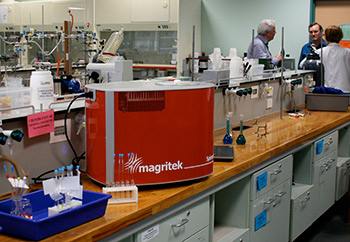Magritek has released three new applications notes to illustrate the versatility of their Spinsolve family of cost-effective benchtop NMR spectrometry solutions.
Spinsolve uses standard 5 mm OD NMR test tubes, exactly the same as high field instruments, so sample handling is familiar and convenient. Spinsolve can be deployed in the lab where immediate results may now be obtained. It is completely safe to operate and the software is straightforward and easy to use. No expert operator is required so it may even be used in a student teaching environment.

The first note shows how NMR may be used to monitor fermentation processes. It is possible to follow the conversion of sugar to ethanol through fermentation without any sample processing. This is illustrated with examples of untreated apple juice. Clear differences between controlled and wild fermentation were detected. The samples were taken straight out of the fermentation vessel without any further processing or purification. This shows that the Spinsolve spectrometer can be readily used as an on-line process monitoring tool.
Most discussions on proton NMR spectroscopy are based on the fact that spectra are typically recorded in solutions prepared with deuterated solvents. The reason for this is that a protonated solvent will give rise to large solvent peaks which may obscure spectral features of the solute. Furthermore, most modern NMR spectrometers rely on the solvent’s deuterium signal for shimming and locking. Although there are certain advantages in using proton-free solvents, it may be desirable to examine a reaction or a product in its native solution. Magritek’s Spinsolve benchtop NMR uses a fast external lock and does therefore not require deuterated solvents for high-resolution performance. In this applications note, representative examples of proton NMR spectra recorded in fully protonated solvents are shown.
In the final note, NMR is used to look at organometallic complexes containing paramagnetic ions. These extend the chemical shift range of proton spectra to hundreds of ppm. At high field, such large bandwidths are very challenging to achieve. The Spinsolve spectrometer has a special Paramagnetic protocol designed to scan such samples. The acquisition bandwidth is 20 kHz corresponding to 480 ppm frequency range. Since paramagnetic ions also reduce the T1 relaxation time of the sample, the repetition time between scans is reduced to 3 seconds resulting in faster scan times. The examples in this note demonstrate the ability of the Paramagnetic protocol to resolve peaks which are not visible in the standard 1D Proton protocol.
Download all of these notes from the Magritek web site where you can also obtain full details of the Spinsolve benchtop NMR spectrometer and the full range of analytical products from Magritek, visit their website here.